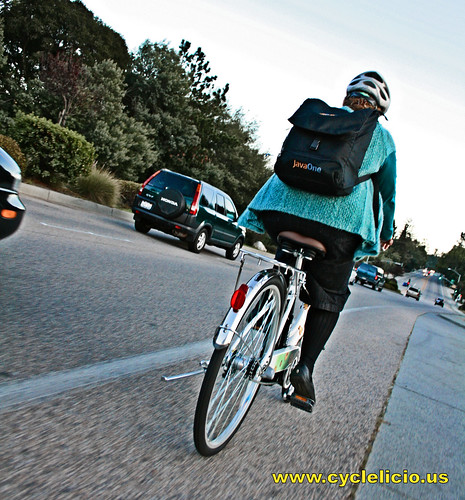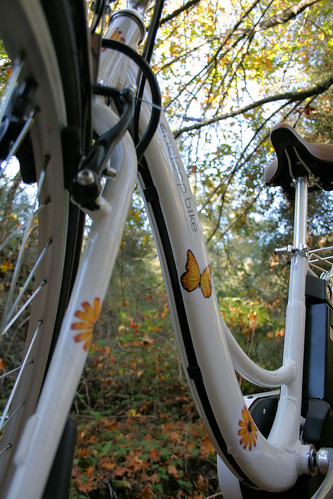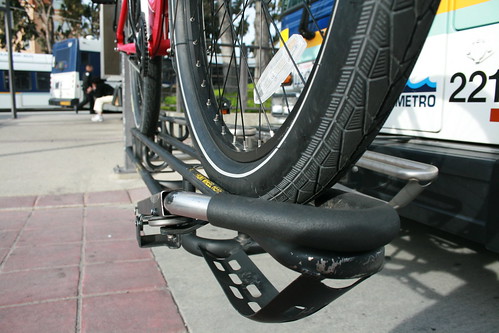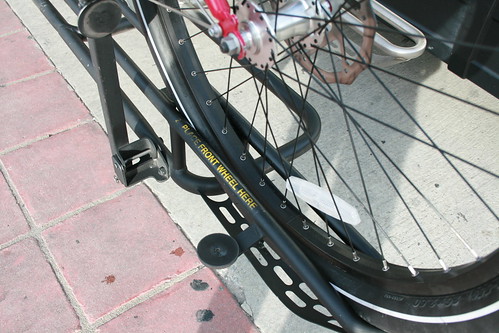Momentum Magazine published their 2010 Gear Issue this week, which includes my very short review of Sanyo’s “Eneloop” electric bicycle.

I wanted a simile to describe this bike’s fun yet practical style and I thought immediately of the mullet — “business in the front, party in the back!” My wife immediately made a face (I can’t imagine why), and suggested I liken the bike to the Little Black Dress. I think it’s perfect.
Like I describe in the review, the Eneloop bike is very practical with its 3 speed hub, sturdy rack, chainguard, lighting and kickstand. I personally think the Japanese styling is appealing and friendly.
Many eBikes are fairly ugly, in my opinion. Attempts to integrate the battery case and wiring harness with the look of the bike often fall short. Sanyo’s been selling electric bikes in Japan for 15 years now and their experience shows. I like how they tuck their Lithium Ion battery between the seatpost and rear wheel, and check out this channel where wiring and cables are routed through the downtube’s underside:

Other cool features:
Integrated lightning. The lights are powered by the same battery that powers the motor, and they’re turned on with a single button on the handlebar. This is a big plus for me — I don’t need to flip a different switch for each light, and I don’t need to remove lights and batteries when I park the bike.

Brake light. Grab the rear brake lever and the tail light flashes quickly, like some motorcycle brake lights you might have seen.
Regenerative braking. The usual argument against regenerative braking on eBikes is it adds significant expense, weight and complexity to a bike for little gain, but Sanyo seems to have managed this technology and it seems to work. When coasting downhill, you can feel the drag from the front motor as it charges the battery. (This coasting recharge can be disabled with a touch of the control panel). Charging also occurs during braking. More than a gee whiz feature, Sanyo claims they can use a smaller, lighter battery with a range of up to 40 miles. I haven’t tested this claim — the farthest I’ve gone on a single charge was 12 miles and I nearly drained the battery, but that ride wasn’t a good test because it was on a park bike path with extremely steep hills (Pipeline Road in Henry Cowell Redwoods State Park, for those who know Santa Cruz, California).
Unlike some electric bikes which have a throttle to control motor speed, the Sanyo eBike is an electric assist bike. This means you must pedal the bike to get the power assist from the front hub motor. The Eneloop bike top speed of 15 mph may be a touch slow for enthusiasts, but it’s a good speed for many city cyclists who prefer a slower pace.
Unlike some other eBikes I’ve tried, pushing the Eneloop beyond 15 mph under my own pedal power is very difficult. I pushed to sprint across an intersection and not much happened – Eneloop just puttered along at its happy 15 mph pace. This may be due simply to the ‘mamachari’ style of the bike — the frame is not based on a performance design, but on the standard Japanese city bike that’s ridden to the train station and local market every day at very slow speed.
Petite individuals will love the sizing of the Sanyo eBike. It comes in a one size fits most with adjustable seatpost and handlebar stem, and everything about the bike is sized perfectly — smaller handlebar grips, smaller controls, and short reach brake levers. For me (5’9″ male with average size hands and proportions), I had to extend the seatpost beyond the minimum insertion line for me to pedal comfortably, and the grips felt just a hair small for me.
The Sanyo Eneloop eBike is a cute, fun and very practical bike. It seems very sturdy and well built with no mystery rattles. My wife has generally been an eBike sceptic (“it feels like cheating!”), but she loves the look and feel of the Eneloop.
Sanyo sells this bike only through independent bike dealers and specialty electric bike shops. In the United States, the Eneloop bike is available at Electric Cyclery in Los Angeles, Philly Electric Wheels Philadelphia, and NYCeWheels New York City.
See also:
* Sanyo Eneloop Bicycle.
* James @ Bicycle Design promises an Eneloop review Real Soon Now. In the meantime, take a look at this National Park Concept Bike.
 NAHBS Attendees: See Pedaler Clothing at Carytown Bicycle Company, Richmond, VA. Details below.
NAHBS Attendees: See Pedaler Clothing at Carytown Bicycle Company, Richmond, VA. Details below.




